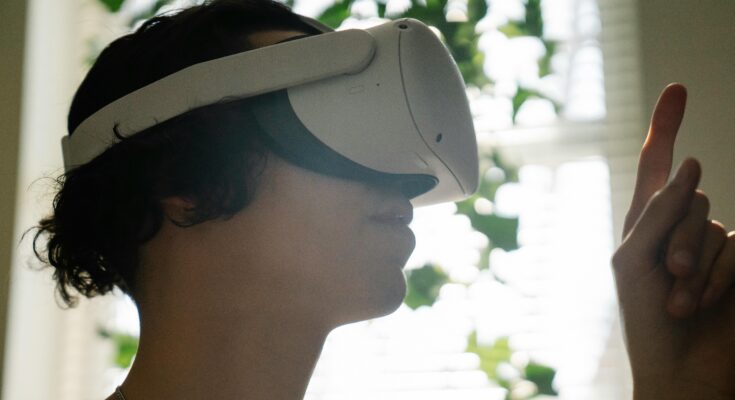Learn More On The Virtual Reality In Healthcare Market:
https://www.thebusinessresearchcompany.com/report/virtual-reality-in-healthcare-global-market-report
According to The Business Research Company’s Virtual Reality In Healthcare, The virtual reality in healthcare market size has grown exponentially in recent years. It will grow from $2.94 billion in 2023 to $4.26 billion in 2024 at a compound annual growth rate (CAGR) of 44.9%. The growth in the historic period can be attributed to rise of chronic diseases, pain management and distraction therapy, telemedicine and remote consultations, patient-centric healthcare approach, increased acceptance by healthcare professionals..
The virtual reality in healthcare market size is expected to see exponential growth in the next few years. It will grow to $19.46 billion in 2028 at a compound annual growth rate (CAGR) of 46.2%. The growth in the forecast period can be attributed to remote training and simulation, integration with wearable devices, real-time surgical assistance, immersive therapy for neurological disorders, expanding applications in medical training.. Major trends in the forecast period include advancements in vr technology, ai integration for personalized treatment, enhanced visualization in medical imaging, vr-based preoperative planning, virtual health communities..
The rise in incidences of neurological disorders is driving the growth of virtual reality in the healthcare market. Neurological disorders are diseases such as Alzheimer’s disease, Parkinson’s disease, dementia, multiple sclerosis, migraines, and others that affect the body’s central nervous system. Immersive VR technology assists in the development of promising applications for the treatment of neurological illnesses. Virtual Reality in Neurology is cost-efficient, patient-friendly, useful for both normal and pathological ageing, and gives ecological validity that standard neuropsychological tests do not provide. For instance, in February 2022, according to the World Health Organization (WHO), a Switzerland-based agency of the United Nations responsible for international public health, epilepsy affects about 50 million individuals worldwide, making it one of the most prevalent neurological conditions worldwide and people with epilepsy make up over 80% of the population in low- and middle-income nations. Therefore, the rise in incidences of neurological disorders is expected to fuel the growth of virtual reality in the healthcare industry going forward.
Get A Free Sample Of The Report (Includes Graphs And Tables):
https://www.thebusinessresearchcompany.com/sample.aspx?id=5948&type=smp
The virtual reality in healthcare market covered in this report is segmented –
1) By Component: Hardware, Software
2) By Technology: Full Immersive Virtual Reality, Non-Immersive Virtual Reality, Semi-Immersive Virtual Reality
3) By Device Type: Head-Mounted Display, Gesture-Tracking Device, Projectors and Display Units, Other Devices
4) By Application: Patient Care Management, Education And Training, Fitness Management, Pharmacy, Surgery, Other Applications
5) By End User: Research And Diagnostics, Laboratories, Hospitals And Clinics, Pharmaceutical Companies, Other End Users
Growing technological advancements are shaping virtual reality in the healthcare market. Major companies operating in virtual reality in the healthcare sector are focusing on developing new technological solutions for the healthcare industry to strengthen their position in the market. For instance, in March 2021, the National Health Service (NHS), a UK-based government department, launched a free treatment plan that uses virtual reality technology to help people with trypanophobia conquer their phobias and receive their vaccinations without anxiety. With this plan, patients can train their brains to overcome the fear of needles by engaging in learning exercises and breathing techniques.
The virtual reality in healthcare market report table of contents includes:
1. Executive Summary
2. Virtual Reality In Healthcare Market Characteristics
3. Virtual Reality In Healthcare Market Trends And Strategies
4. Virtual Reality In Healthcare Market – Macro Economic Scenario
5. Global Virtual Reality In Healthcare Market Size and Growth
…………….
31. Global Virtual Reality In Healthcare Market Competitive Benchmarking
32. Global Virtual Reality In Healthcare Market Competitive Dashboard
33. Key Mergers And Acquisitions In The Virtual Reality In Healthcare Market
34. Virtual Reality In Healthcare Market Future Outlook and Potential Analysis
35. Appendix
Related Reports:
https://goodprnews.com/rubber-tired-gantry-crane-market-trends/
https://goodprnews.com/sales-performance-management-market-analysis/
https://goodprnews.com/same-day-delivery-services-market-share/
https://topprnews.com/rubber-tired-gantry-crane-market-forecast/
https://topprnews.com/sales-performance-management-market-analysis/
https://topprnews.com/same-day-delivery-services-market-insights/
Contact Us:
The Business Research Company
Europe: +44 207 1930 708
Asia: +91 88972 63534
Americas: +1 315 623 0293
Email: [email protected]
Follow Us On:
LinkedIn: https://in.linkedin.com/company/the-business-research-company
Twitter: https://twitter.com/tbrc_info
Facebook: https://www.facebook.com/TheBusinessResearchCompany
YouTube: https://www.youtube.com/channel/UC24_fI0rV8cR5DxlCpgmyFQ
Blog: https://blog.tbrc.info/
Healthcare Blog: https://healthcareresearchreports.com/
Global Market Model: https://www.thebusinessresearchcompany.com/global-market-model



